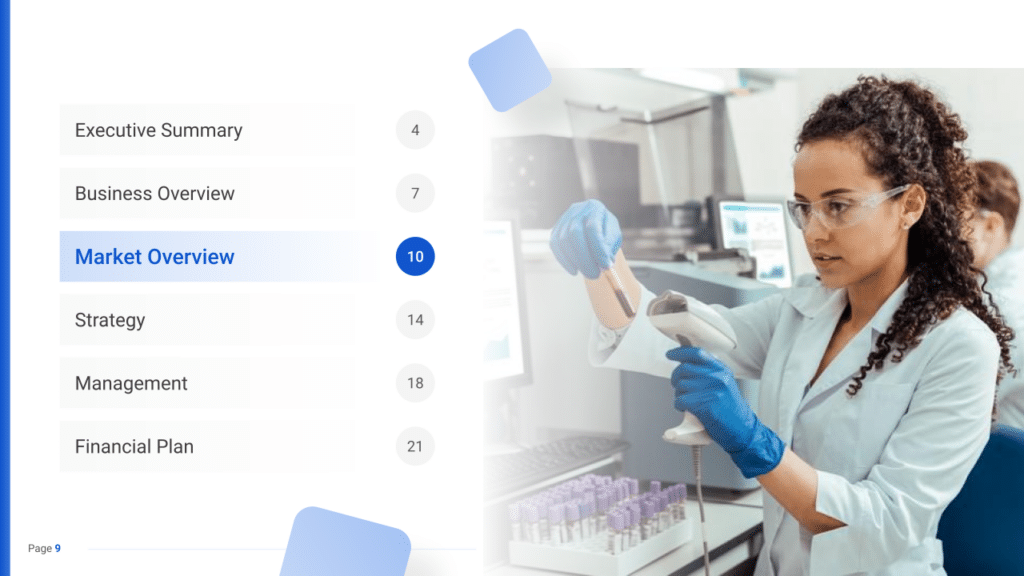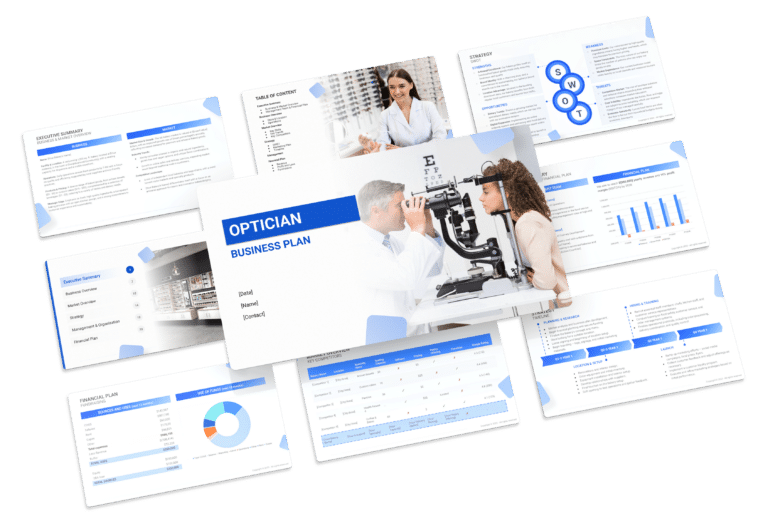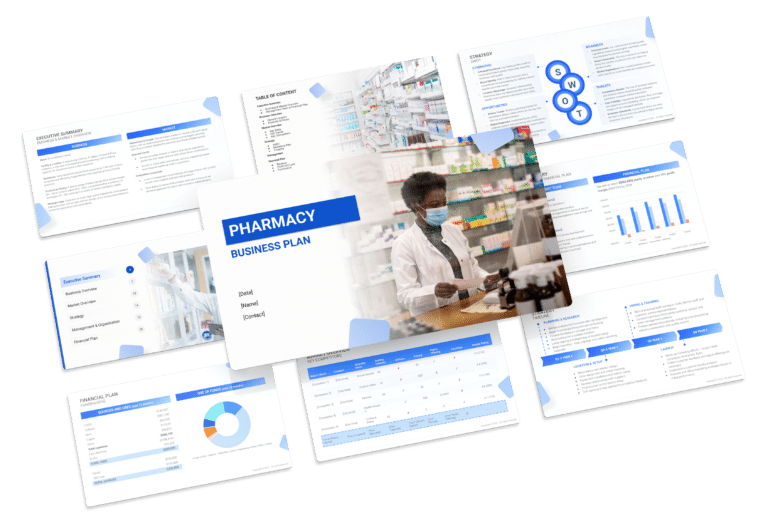Medical Laboratory Business Plan Template & PDF Example

Creating a comprehensive business plan is crucial for launching and running a successful medical laboratory business. This plan serves as your roadmap, detailing your vision, operational strategies, and financial plan. It helps establish your medical laboratory business’s identity, navigate the competitive market, and secure funding for growth.
This article not only breaks down the critical components of a medical laboratory business plan, but also provides an example of a business plan to help you craft your own.
Whether you’re an experienced entrepreneur or new to the service industry, this guide, complete with a business plan example, lays the groundwork for turning your medical laboratory business concept into reality. Let’s dive in!
The Plan
Our medical laboratory business plan is structured to encompass all crucial components necessary for a detailed and strategic approach. It delineates the laboratory’s operational procedures, marketing tactics, market landscape, competition, management personnel, and financial projections.
- Executive Summary: Provides a concise overview of the medical laboratory’s business concept, market analysis, management team, and financial strategy.
- Business Overview: Offers a detailed look at what the medical laboratory will provide and its operational framework.
- Laboratory & Location: Describes the laboratory’s facilities, technology, and the strategic benefits of its location for both clients and operational efficiency.
- Services & Pricing: Outlines the diagnostic and research services the medical laboratory will offer, including a comprehensive pricing structure.
- Market Overview: Examines the landscape of the healthcare and diagnostics industry, highlighting the medical laboratory’s position within it.
- Key Stats: Presents statistics on the healthcare industry’s size, growth trends, and the demand for laboratory services.
- Key Trends: Identifies major trends in healthcare diagnostics and research that could impact the laboratory.
- Key Competitors: Analyzes the main competitors in the area and differentiates your laboratory’s services from theirs.
- Strategy: Delineates the strategic approach the medical laboratory will take to achieve its objectives and attract clientele.
- SWOT Analysis: Conducts a thorough evaluation of the Strengths, Weaknesses, Opportunities, and Threats related to the medical laboratory business.
- Marketing Plan: Details the strategies for marketing the laboratory’s services to healthcare providers, clinics, and research institutions.
- Timeline: Establishes key milestones and goals for the laboratory from startup through the first year of operation.
- Management: Provides information about the qualifications and roles of the team managing the medical laboratory.
- Financial Plan: Forecasts the laboratory’s financial performance over the next five years, including expected revenue, profit margins, and significant expenses.

Executive Summary
The Executive Summary introduces your medical laboratory’s business plan, offering a concise overview of your laboratory and its diagnostic services. It should detail your market positioning, the spectrum of diagnostic and testing services you provide, its location, size, and an outline of day-to-day operations.
This section should also explore how your medical laboratory will integrate into the healthcare ecosystem, including the number of direct competitors within the area, identifying who they are, along with your laboratory’s unique selling points that differentiate it from these competitors.
Furthermore, you should include information about the management and founding team, detailing their roles and contributions to the laboratory’s success.
Additionally, a summary of your financial projections, including revenue and profits over the next five years, should be presented here to provide a clear picture of your laboratory’s financial plan.
Medical Laboratory Business Plan Executive Summary Example


Business Overview
When outlining your laboratory’s overview, it’s important to present clear and succinct details. This encompasses the name of your laboratory, its strategic location, and a snapshot of its daily operations.
These elements not only introduce your laboratory but also highlight its distinctive features. A unique selling proposition (USP) is key—it distinguishes your laboratory from competitors. Whether it’s your cutting-edge technology, a wide array of specialized tests, or your commitment to rapid, accurate results, the USP should be the highlight of your executive summary, attracting the attention of your audience and demonstrating the unique value your laboratory brings to the healthcare industry.
Example:
For instance, “Advanced Diagnostics Laboratory” is strategically located in the health district of Metro City, occupying a state-of-the-art 2,000 sq. ft. facility. It specializes in a broad spectrum of diagnostic tests, from routine blood work to complex genetic screenings. Their USP lies in their rapid turnaround times and the integration of AI for enhanced diagnostic precision, setting them apart in a competitive market.
Market Overview
A thorough understanding and presentation of the healthcare market’s size, growth trends, and dynamics are crucial. This section should illuminate the potential of the specific laboratory services market, supported by relevant statistics such as market value and growth rates. Discussing trends like the increasing demand for personalized medicine or telehealth services can offer insights into the evolving healthcare landscape and your laboratory’s place within it.
Identifying key competitors and your laboratory’s competitive edge is vital. Whether through specialized services, exceptional patient care, or innovative testing methods, this is your chance to show how your laboratory is uniquely positioned to succeed in a crowded field.
Example:
In the context of the burgeoning U.S. medical laboratory market, valued at $37.4 billion in 2023 with a forecasted steady growth rate of +6.5% from 2024 to 2030, “Advanced Diagnostics Laboratory” stands out in the competitive landscape of Metro City. Amidst [5] key competitors that range from specialized laboratories to comprehensive primary care clinics, Advanced Diagnostics carves a niche for itself with its strategic location, an extensive array of competitively priced lab services, extended hours, and personalized patient care. These strategic advantages not only cater to the increasing health consciousness, the aging population, and the demand for outpatient services but also ensure an unparalleled patient experience, setting Advanced Diagnostics apart in a crowded market.
Management Team
Your management team’s expertise and background are invaluable assets. Highlight the qualifications and experiences of key team members in your executive summary, building credibility and assuring potential investors of your laboratory’s capacity for success.
Example:
“Advanced Diagnostics Laboratory” is led by co-founders Dr. Emily Chen and Dr. Raj Patel. Dr. Chen, a PhD in molecular biology with over 20 years of research experience, oversees the laboratory’s scientific and technological advancements. Dr. Patel, with an MBA and a background in healthcare management, directs business operations, ensuring efficiency and growth. Together, they bring a formidable combination of scientific expertise and business acumen to the laboratory.
Financial Plan
Your financial overview should concisely summarize the laboratory’s financial objectives and projections, including revenue targets and profit margins, to provide a clear picture of your laboratory’s financial future.
Example:
With the ambitious goal of achieving $3.2 million in annual revenue by 2028, “Advanced Diagnostics Laboratory” is on a path to financial success, aiming for a robust 31% profit margin (EBITDA margin). This financial vision is grounded in the laboratory’s strategic positioning within the vibrant medical laboratory market and its commitment to operational excellence. By leveraging state-of-the-art diagnostic technology, offering a wide range of essential to advanced tests, and focusing on patient-centric services, Advanced Diagnostics is poised to not only meet but exceed its financial targets, establishing itself as a leader in the medical laboratory sector.
Business Overview
For a Medical Laboratory, the Business Overview section can be effectively divided into 2 main parts:
Laboratory & Location
Briefly describe the laboratory’s physical setup, emphasizing its state-of-the-art equipment, cleanliness, and the professional atmosphere that assures clients of high-quality diagnostic services.
Mention the laboratory’s location, highlighting its accessibility to both patients and healthcare providers, such as proximity to medical centers or clinics, and the convenience it offers, like ample parking or public transport options. Explain why this location is strategically chosen to serve your target clientele efficiently.
Services & Pricing
Detail the array of diagnostic tests and services provided, from routine blood work and urinalysis to more specialized tests like genetic testing, biopsies, or advanced imaging diagnostics.
Outline your pricing strategy, ensuring it is competitive yet reflects the advanced technology and expertise involved in providing these services. Highlight any partnerships with insurance providers, bulk testing packages, or membership deals that offer cost-effective solutions to patients and healthcare providers, fostering long-term relationships and client loyalty.


Market Overview

Industry size & growth
In the Market Overview of your medical laboratory business plan, begin by assessing the size of the medical diagnostics industry and its growth potential. This analysis is essential for grasping the market’s breadth and pinpointing opportunities for expansion.
Key market trends
Next, delve into recent market trends, such as the growing demand for personalized and precision medicine, the increased use of telehealth services, and advancements in diagnostic technologies.
For instance, emphasize the need for diagnostic services that support personalized treatment plans and the growing interest in home-based testing kits. Also, consider the impact of digital health technologies on laboratory services, such as online access to test results and integration with electronic health records.
Competitive Landscape
A competitive analysis is not just a tool for gauging the position of your medical laboratory in the market and its key competitors; it’s also a fundamental component of your business plan.
This analysis helps in identifying your medical laboratory’s unique selling points, essential for differentiating your business in a competitive market.
In addition, the competitive analysis is integral in laying a solid foundation for your business plan. By examining various operational aspects of your competitors, you gain valuable information that ensures your business plan is robust, informed, and tailored to succeed in the current market environment.
Identifying Your Competitors in the Medical Laboratory Sector
The initial step towards understanding your market position involves identifying your competitors. Start by cataloging local medical laboratories and diagnostic centers. For instance, if your laboratory specializes in genetic testing, your direct competitors would include nearby labs that offer similar genetic services, as well as larger hospital-affiliated laboratories. It’s also important to consider indirect competitors like online diagnostic services that provide mail-in testing kits.
Utilize digital tools like Google Maps for a geographical overview of competitor locations. Websites such as Healthgrades or RateMDs can offer patient reviews and ratings, shedding light on your competitors’ strengths and weaknesses. For instance, if multiple reviews praise the quick turnaround time and accuracy of “Precision Diagnostics,” this represents a significant strength of your competitor.

Medical Laboratory Competitors’ Strategies
When analyzing your competitors’ strategies, consider several factors:
- Diagnostic Services Offered: Investigate the range of tests and services provided. If “NextGen Labs” is becoming popular for its comprehensive metabolic panels and advanced biomarker tests, this could indicate a trend towards more detailed diagnostic services.
- Technological Advancements: Evaluate the technology and methodologies employed. A lab like “Innovative Diagnostics” that uses cutting-edge molecular techniques might cater to a different clientele than a lab focusing on standard pathology tests.
- Pricing and Insurance Partnerships: Analyze how your services are priced in comparison to others. Are your tests competitively priced against those offered by “Affordable Labs,” or do they align more with the specialized services at “Elite Diagnostics”?
- Marketing and Outreach: Examine how competitors promote their services. Do they have a strong online presence, or do they engage more with healthcare providers and clinics directly?
- Patient Experience: Consider the patient journey. For example, “Friendly Lab Services” may be renowned for its patient-centric approach and minimal wait times, which significantly enhances the patient experience.
- Operational Efficiency: Look into whether competitors are leveraging technology or innovative processes to improve efficiency, such as “Streamline Labs” with its digital report delivery system.
What’s Your Medical Laboratory Value Proposition?
Consider your laboratory’s unique selling proposition. Perhaps your lab is renowned for its rapid test results, or maybe you offer a rare test that isn’t available elsewhere in your region.
Identify market opportunities through patient feedback and healthcare trends. For instance, the increasing demand for personalized medicine and genetic testing could be a niche if competitors have yet to meet this need.
Consider your laboratory’s location: A lab situated in a medical hub might focus on specialized tests and services for healthcare professionals, whereas a lab in a community setting might prioritize general diagnostic services and accessibility for the general public.
Strategy

SWOT
First, conduct a SWOT analysis for the medical laboratory, highlighting Strengths (such as advanced diagnostic technology and specialized testing capabilities), Weaknesses (including high operational and equipment costs or regulatory challenges), Opportunities (for example, the growing demand for preventive healthcare and diagnostic testing), and Threats (such as changes in healthcare policies that may affect reimbursement rates for tests).

Marketing Plan
Next, develop a marketing strategy that outlines how to establish partnerships with healthcare providers, attract patients through targeted advertising, offer competitive pricing or package deals, maintain an informative and engaging online presence, and participate in health fairs and community health initiatives.
Marketing Channels
Utilize various marketing channels to effectively communicate your laboratory’s brand, services, and expertise to potential clients.
Digital Marketing
Leverage the power of digital platforms:
- Website and SEO: Develop a professional, user-friendly website highlighting services, accreditations, expert team profiles, and educational content. Optimize for SEO to ensure visibility in online searches for specific medical tests or services.
- Content Marketing: Share informative blog posts, case studies, or whitepapers showcasing your laboratory’s expertise and industry insights. Distribute these across social media platforms and newsletters.
- Social Media Engagement: Engage with the audience through LinkedIn for professional connections, Twitter for industry updates, and Facebook for community engagement. Share informative content and interact with comments and inquiries.
- Email Marketing: Develop an email list and send regular newsletters offering valuable insights, updates on medical advancements, and promotional offers.
Local Outreach and Collaborations
Forge connections within the local community:
- Networking with Healthcare Providers: Engaging with doctors, clinics, hospitals, and practitioners through educational seminars or collaborative ventures fosters relationships and facilitates referrals.
- Community Health Initiatives: Participating in health fairs, wellness workshops, or sponsoring local health-related events not only raises awareness about your laboratory but also showcases your commitment to community health.
Promotional Activities
Engage potential clients through special offerings:
- Introductory Packages: Introduce special discounts or bundled testing packages for first-time clients or specific diagnostic tests.
- Referral Incentives: Encourage existing clients and healthcare partners to refer new patients by offering incentives or discounts for each successful referral.

Sales Channels
Implement effective sales channels to cater to client needs and maximize revenue streams.
Client-Centric Services
- Upselling Services: Offer additional services or test packages during consultations or appointments based on patient requirements or medical history.
- Educational Sales Approach: Train staff to provide informative guidance about various tests or services, focusing on how they benefit the patient’s health and well-being.
Online Booking and Service Sales
Streamline sales processes through digital platforms:
- Online Appointment Booking: Enable easy and user-friendly online appointment scheduling on your website or through apps to facilitate convenience for clients.
- E-Commerce for Test Kits: Offer online sales of specific test kits, ensuring clarity in instructions and support for any inquiries.
Membership and Loyalty Programs
Foster client loyalty and repeat business:
- Membership Benefits: Develop a membership program offering exclusive discounts, priority appointments, or additional services for frequent clients or subscription-based healthcare programs.
- Loyalty Rewards: Institute a digital loyalty program where clients earn points per test or service, redeemable for discounts on future tests or services.
Strategy Timeline
Finally, create a detailed timeline that outlines critical milestones for the medical laboratory’s establishment, marketing initiatives, partnership development, service expansion, and operational objectives, ensuring the business advances with clear direction and purpose.

Management
The Management section focuses on the medical laboratory business’s management and their direct roles in daily operations and strategic direction. This part is crucial for understanding who is responsible for making key decisions and driving the medical laboratory business toward its financial and operational goals.
For your medical laboratory business plan, list the core team members, their specific responsibilities, and how their expertise supports the business.


Financial Plan
The Financial Plan section is a comprehensive analysis of your financial projections for revenue, expenses, and profitability. It lays out your medical laboratory business’s approach to securing funding, managing cash flow, and achieving breakeven.
This section typically includes detailed forecasts for the first 5 years of operation, highlighting expected revenue, operating costs and capital expenditures.
For your medical laboratory business plan, provide a snapshot of your financial statement (profit and loss, balance sheet, cash flow statement), as well as your key assumptions (e.g. number of customers and prices, expenses, etc.).
Make sure to cover here
_ Profit and Loss
_ Cash Flow Statement
_ Balance Sheet
_ Use of Funds









